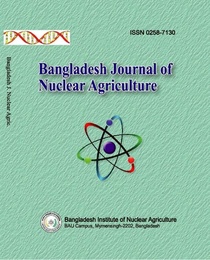PROMISING SALT TOLERANT SOYBEAN MUTANTS DEVELOPED THROUGH GAMMA RAY IRRADIATION (Short communication)
Abstract
An experiment was conducted to evaluate the performance of three promising lines along with two check varieties of soybean in respect of plant height, branches per plant, pods per plant, seeds per pod, days to maturity and seed yield, at five different locations during January to April 2022. Significant variations were observed both in individual location and combined over locations for all traits. Among the mutants, average days to maturity ranged from 109-114 days. It indicated that, all the mutant lines as well as check varieties had prolonged days to maturity, which eventually reflected significantly higher grain yield at all locations. Plant height ranged from 34-62 cm and number of branches plant-1 from 2.9 to 3.6. Mutant SBM-22 produced highest pods plant-1 (76); whereas, the check varieties Binasoybean-2 and Binasoybean-6 produced 43 Hundred seed weight was higher in Binasoybean-2 (13.4g) and lower hundred seed weight was obtained from SBM-26 (11.1g). Seed yield obtain from the mutants and checks significantly differs from each other. Mutant SBM-25 produced the highest seed yield of 2836 kg ha-1. Among the locations, all mutants as well as check varieties gave the highest seed yield at Satkhira. Comparing with imposed salinity level and time, plant height as well as leaf was decreased. All the germinated genotypes were survived at initial salinity 4 dS m-1 (though 4 dS m-1 is not at all a problem for salinity) up to 21 days. All the mutants showed moderately tolerant at same treatment up to 7 days after sowing. Binasoybean-2, Binasoybean-6 and Lokon performed well with the advancement of time. Among the mutants SBM-22 and SBM-26 will be selected on the basis of yield contributed characters for further trials.
References
Birt, D.F., Hendrick, S., Alekel. D.L. and Anthony, M. 2004. Soybean and the prevention of chronic human disease. In: Boerma HR, Specht, JE (eds.) Soybeans: Improvement, Production, and Uses. Agron Monogr, 3rd edn. No. 16, ASA-CSSA-SSSA, Madison, WI, USA, pp 1047–1117.
Gomez, K.A. and Gomez, A.A. 1984. Statistical Procedure for Agricultural Research. 2nd Edn. John Wiley and Sons, New York. 97-411.
Hanafiah, D.S., Trikoesoemaningtyas, T., Yahya, S. and Wirnas, D. 2010. Induced mutations by gamma ray irradiation to Argomulyo soybean (Glycine max) variety. Nusantara Bioscience, 2(3), 121-125.
Hasanuzzaman, M., Nahar, K., Rahman, A., Mahmud, J.A., Hossain, M.S. and Fujita, M. 2016. Soybean production and environmental stresses. In: Miransari M, editor. Environmental Stresses in Soybean Production. London: Academic Press. pp. 61-102.
Hasanuzzaman, M., Parvin, K., Anee, T.I., Masud, A.W.C. and Nowroz, F. 2022. Salt Stress Responses and Tolerance in Soybean. Pp. 1-37. DOI: http://dx.doi.org/10.5772/intechopen.102835.
Hurburgh, C.R.Jr., Brumm, T.J., Guinn, J.M. and Hartwig, R.A. 1990. Protein and oil patterns in US and world soybean markets. J Am Oil Chem Soc 67:966-973.
Hymowitz, T. 2004. Speciation and cytogenetics. In: Boerma HR, Specht JE (eds) Soybeans: improvement, production, and uses. Agron Monogr, 3rd edn. No. 16, ASA-CSSA-SSSA, Madison, WI, USA, pp 97–136.
Khan, M.A., Asaf, S.K.A., Ullah, I., Ali, S. and Kang, S.M. 2019. Alleviation of salt stress response in soybean plants with the endophytic bacterial isolate Curtobacterium sp. SAK1. Annals of Microbiology.69:797-808.
Khan, M.H. and Tyagi, S.D. 2010. Induced morphological mutants in soybean [Glycine max (L.) Merrill]. Frontiers of Agriculture in China 4(2):175-180.
Lusas, E.W. 2004. Soybean processing and utilization. In: Boerma HR, Specht JE (eds.) Soybeans: improvement, production, and uses. Agron Monogr, 3rd edn. No. 16, ASA-CSSA-SSSA, Madison, WI, USA, pp 949–1036.
Ma, L., Kong, F., Sun, K., Wang, T. and Guo, T. 2021. From Classical Radiation to Modern Radiation: Past, Present, and Future of Radiation Mutation Breeding. Front. Public Health 9:768071. doi: 10.3389/fpubh.2021.768071.
Malek, M.A, Emon, R.M., Khatun, M.K., Bhuiyan, M.S.H., Nevame, A.Y.M. and Alam, M.A. 2022. Binasoybean-6: A High Yielding Mutant Soybean Variety Developed through Sustainable Mutation Breeding. Legume Research. 45(2): 143-148.
Nilahayati, Rosmayati, Hanafiah, D.S. and Harahap, F. 2019. The genotype selection of M3 generation of Kipas Putih soybean with gamma-ray irradiation on agronomic characters, early maturity and high yielding mutants. Bulgarian Journal of Agricultural Science, 25(1), 97-102.
Shalini, S.H., Ram, S., Bhushan, S.H. and Ahmad, E. 2016. Genetic variability, heritability and genetic advance of yield and quality traits in linseed (Linumusitatissimum L.). Int. J. Plant Sci. 11 (2), 270–274. https://doi.org/10.15740/HAS/IJPS/11.2/270-274.
Upadhyay, S., Nandan, M. and Ashish, K.T. 2019. Assessment of variability among flax type linseed genotypes (Linumusitatissimum L.) of Chhattisgarh plains. Int. J. Curr. Microbiol. App. Sci. 8 (6), 2633-2637. https://doi.org/10.20546/ijcmas.2019.806.316.
Wilson, R.F. 2004. Seed composition. In: Boerma HR, Specht JE (eds.) Soybeans: improvement, production, and uses. Agron Monogr, 3rd edn. No. 16, ASA-CSSA-SSSA, Madison, WI, USA, pp 621-677.
-
Download



